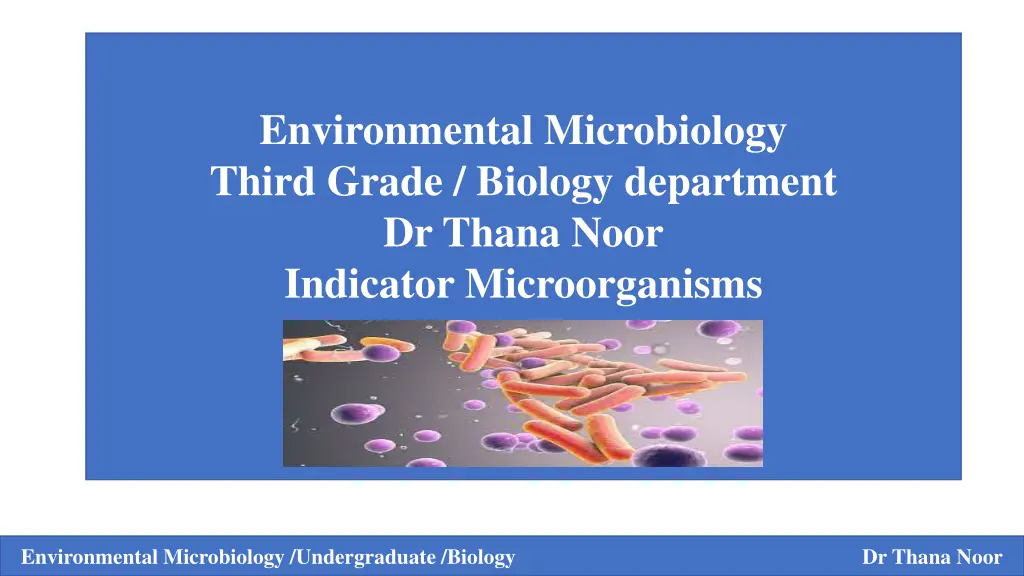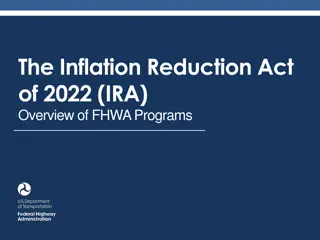
Indicator Microorganisms in Environmental Microbiology: Characteristics and Types
Learn about indicator microorganisms used in environmental microbiology to detect fecal contamination and potential presence of pathogens. Discover the criteria for ideal indicator organisms and the types commonly employed in assessments.
Download Presentation

Please find below an Image/Link to download the presentation.
The content on the website is provided AS IS for your information and personal use only. It may not be sold, licensed, or shared on other websites without obtaining consent from the author. If you encounter any issues during the download, it is possible that the publisher has removed the file from their server.
You are allowed to download the files provided on this website for personal or commercial use, subject to the condition that they are used lawfully. All files are the property of their respective owners.
The content on the website is provided AS IS for your information and personal use only. It may not be sold, licensed, or shared on other websites without obtaining consent from the author.
E N D
Presentation Transcript
Environmental Microbiology Third Grade / Biology department Dr Thana Noor Indicator Microorganisms Environmental Microbiology /Undergraduate /Biology Dr Thana Noor
Characteristic of indicator microorganisms: Its nonpathogenic bacteria exist in feces in all warm blood animals. Whose presence indicates that pathogenic microorganisms may also be present. These bacteria can easily be isolated and quantified by simple bacteriological methods. Detection of these bacteria in water means that fecal contamination has occurred and suggests that enteric pathogens may also be present. What kind of M.O could be found with a great number in feces? - Coliform bacteria, which normally occur in the intestines of all warm blooded animals, are excreted in great numbers in feces. In polluted water, coliform bacteria are found in densities roughly proportional to the degree of fecal pollution because coliform bacteria are generally hardier than disease-causing bacteria, their absence from water is an indication that the water is bacteriologically safe for human consumption. - Many countries have adopted coliforms and other groups of bacteria as official standards for drinking water, recreational bathing waters, wastewater discharges, and various foods. Indicator microorganisms have also been used to assess the efficacy of food processing and water and wastewater treatment processes. As an ideal assessor of fecal contamination. Environmental Microbiology /Undergraduate /Biology Dr Thana Noor
What is the Criteria for an Ideal Indicator Organism 1-The organism should be useful for all types of water. 2. The organism should be present whenever enteric pathogens are present. 3. The organism should have a reasonably longer survival time than the hardiest enteric pathogen. 4. The organism should not grow in water. 5. The testing method should be easy to perform. 6. The density of the indicator organism should have some direct relationship to the degree of fecal pollution. 7. The organism should be a member of the intestinal microflora of warm blooded animals. What are the types of Indicator Organisms 1.Total Coliforms 2. Fecal Coliforms and Escherichia Coli 3. Fecal Streptococci 4. Clostridium Perfringens 5. Bifidobacterium and Bacteroides 6. Heterotrophic Plate Count 7. Bacteriophage Environmental Microbiology /Undergraduate /Biology Dr Thana Noor
Environmental Microbiology /Undergraduate /Biology Dr Thana Noor
Total Coliforms : the coliform group, which includes Escherichia, Citrobacter, Enterobacter, and Klebsiella species, is relatively easy to detect. What are the basic features that total coliform are specialized with? Aerobic and facultatively anaerobic, gram-negative, non spore-forming, rod-shaped bacteria that produce gas after lactose fermentation. The coliform group has been used as the standard for assessing fecal contamination of recreational (water in swimming pools, hot tubs, water parks, water play areas, interactive fountains, lakes, rivers, or oceans) and drinking waters since early in the twentieth century. Through experience it has been learned that absence of this organism in 100 ml of drinking water ensures the prevention of bacterial waterborne disease outbreaks. How many methods are commonly used to identify coliforms in water? 1- The most probable number (MPN). 2-The membrane filter (MF). 3- The presence absence tests (P-A)Tests. Environmental Microbiology /Undergraduate /Biology Dr Thana Noor
Fecal Coliforms and Escherichia Coli Although the total coliform group has served as the main indicator of water pollution for many years, but many of the organisms in this group are not limited to fecal sources. Thus, methods have been developed to restrict the enumeration to coliforms that are more clearly of fecal origin, that is, the fecal coliforms. These organisms, which include the genera Escherichia and Klebsiella, fecal coliforms may be detected by methods similar to those used for coliform bacteria. Fecal Streptococci The fecal streptococci are a group of gram-positive Lancefield group D streptococci. The fecal streptococci belong to the genera Enterococcus and Streptococcus. This group share biochemical properties and have a wide range of tolerance of adverse growth conditions. The genus Enterococcus include Ent. avium, Ent. faecium, Ent. durans, Ent. faecalis, that characterized by their ability to grow in 6.5% sodium chloride, pH 9.6, and 45 C .The genus Streptococcus , only S. bovis and S. equinus are found in animals; Ent. faecalis and Ent. faecium are found in the human gut. It has been suggested that a fecal coliform/ fecal streptococci (FC/FS) ratio of 4 or more indicates a contamination of human origin, whereas a ratio below 0.7 is indicative of animal pollution. Fecal streptococci are considered to have certain advantages over the coliform. Environmental Microbiology /Undergraduate /Biology Dr Thana Noor
Fecal coliform bacteria as indicators: o They are rearly multiply in water o They are more resistance to environmental stress and clorination than coliforms. o They persist longer in the environment. Clostridium Perfringens Clostridium perfringens is a sulfite-reducing anaerobic spore former; it is gram positive, rod shaped, and exclusively of fecal origin. The spores are very heat resistant (75 C for 15 min), persist for long periods in the environment, and are very resistant to disinfectants . it has been suggested that it could be an indicator of past pollution, and an indicator of removal of protozoan parasites or viruses during drinking water and wastewater treatment. Bifidobacterium and Bacteroides They are anaerobic bacteria have been suggested as potential indicators. Because some Bifidobacterium are primarily associated with humans, so they could help distinguish between human and animal contamination. Environmental Microbiology /Undergraduate /Biology Dr Thana Noor
Heterotrophic Plate Count This group includes gram-negative bacteria belonging to the following genera: Pseudomonas, Aeromonas, Klebsiella, Flavobacterium, Enterobacter, Citrobacter, Serratia, Acinetobacter, Proteus, Alcaligenes, Enterobacter, and Moraxella. The heterotrophic plate counts of microorganisms found in untreated drinking water and chlorinated distribution water. These bacteria are commonly isolated from surface waters and groundwater, and are widespread in soil and vegetation. heterotrophic plate counts (HPC) indicate variation in water quality and potential for pathogen survival and regrowth. It has been recommended that the HPC should not exceed 500 per ml in tap water. Bacteriophage Because of their constant presence in sewage and polluted waters, the use of bacteriophage as indicators of fecal pollution also been suggested as indicators of viral pollution. bacteriophage as indicators because the structure, morphology, and size as well as the behavior in the aquatic environment of many bacteriophage closely resemble those of enteric viruses. For these reasons, they have also been used to evaluate virus resistance to disinfectants, to evaluate virus fate during water and wastewater treatment, and as surface and groundwater tracers. The use of bacteriophage as indicators of fecal pollution is based on the assumption that their presence in water samples denotes the presence of bacteria capable of supporting the replication of the phage. The phage have been studied as indicators was the somatic coliphage, which infect E. coli host strains. Advantage of using coliphage is that they can be detected by simple and inexpensive techniques that yield results in 8 18 h. Environmental Microbiology /Undergraduate /Biology Dr Thana Noor
Bacteriophage of Bacteroides fragilis have also been suggested as indicators of human viruses in the environment. Bacteroides spp. are strict anaerobes and are a major component of human feces, so bacteriophage active against these organisms have the potential to be suitable indicators of viral contamination , Bacteriophage of Bacteroides fragilis appear to be present only in environmental samples contaminated with human fecal pollution. This may help to differentiate human from animal contamination. Wastewater Treatment and Biosolids Reuse In the past centuries, in cities, simply collected wastes and discharged them into the nearest lake, river, or ocean. But in modern-day sewage is treated before it is discharged into the environment. Domestic wastewater is primarily a combination of human feces, urine, and gray water. Gray water results from washing, bathing, and meal preparation. Water from various industries and businesses may also enter the system. The amount of organic matter in domestic wastes determines the degree of biological treatment required. Three tests are used to assess the amount of organic matter: Biochemical oxygen demand (BOD). Chemical oxygen demand (COD). Total organic carbon (TOC). Environmental Microbiology /Undergraduate /Biology Dr Thana Noor
Biochemical oxygen demand (BOD): is the amount of dissolved oxygen consumed by microorganisms during the biochemical oxidation of organic and inorganic matter. Why BOD test is commonly used ? 1. To determine the amount of oxygen that will be required for biological treatment of the organic matter present in a wastewater. 2. To determine the size of the waste treatment facility needed. 3. To assess the efficiency of treatment processes. 4. To determine compliance with wastewater discharge permits. Chemical oxygen demand (COD): is the amount of oxygen necessary to oxidize all of the organic carbon completely to CO2 and H2O. Normally, the ratio BOD/COD is approximately 0.5. When this ratio falls below 0.3, it means that the sample contains large amounts of organic compounds that are not easily biodegraded. Environmental Microbiology /Undergraduate /Biology Dr Thana Noor
Total organic carbon (TOC): is determined by oxidation of the organic matter with heat and oxygen, followed by measurement of the CO2 liberated. Both TOC and COD represent the concentration of both biodegradable and nonbiodegradable organics in water. Pathogenic microorganisms are almost always present in domestic wastewater numbers of pathogenic microorganisms may be excreted by infected individuals. Both symptomatic and asymptomatic individuals may excrete pathogens. For example, the concentration of rotavirus may be as high as 1010 virions per gram of stool. Modern Wastewater Treatment The wastewater treatment is the removal and degradation of organic matter under controlled conditions. Complete sewage treatment comprises three major steps, primary, secondary, and tertiary treatment. Environmental Microbiology /Undergraduate /Biology Dr Thana Noor
1. Primary Treatment: Primary treatment is the first step in municipal sewage treatment and it involves physically separating large solids from the waste stream such as branches and tires .Microbial pathogens are not effectively removed from the effluent in the primary process. 2. Secondary Treatment: Secondary treatment consists of biological degradation, in which the remaining suspended solids are decomposed by microorganisms and the number of pathogens is reduced. A disinfection step is generally included at the end of the treatment. 3. Tertiary Treatment: Tertiary treatment involves a series of additional steps to reduce organics, turbidity, nitrogen, phosphorus, metals, and pathogens. Most processes involve some type of physicochemical treatment such as coagulation, filtration, activated carbon adsorption of organics, reverse osmosis, and additional disinfection. Environmental Microbiology /Undergraduate /Biology Dr Thana Noor






















